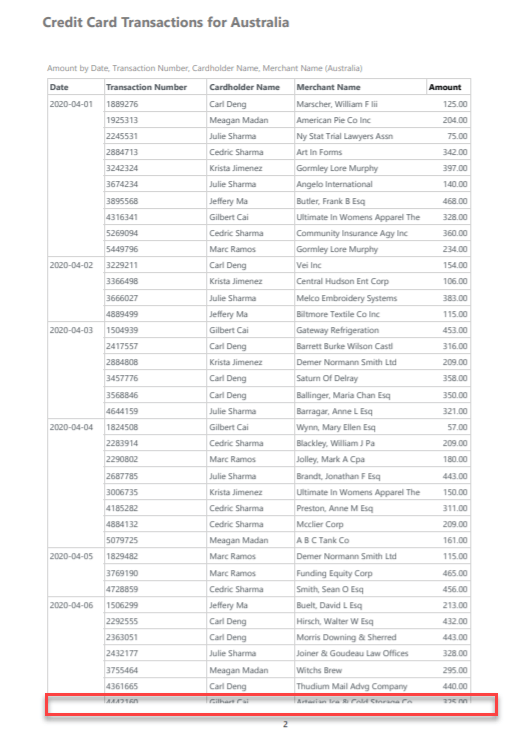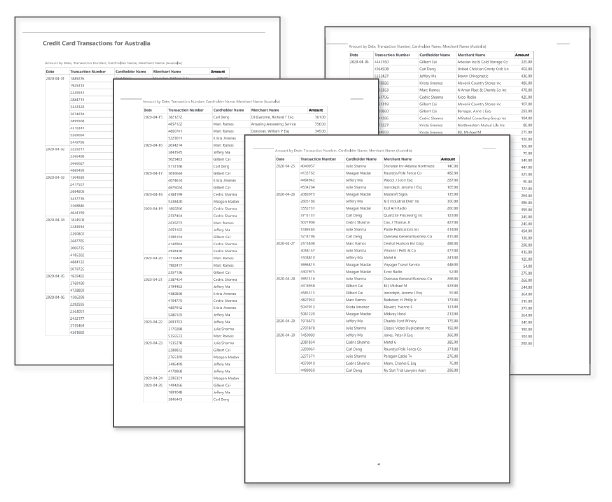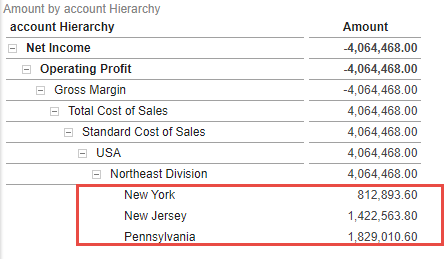2020.10 is the latest release from Pyramid Analytics. It extends the functionality introduced in our major 2020 release. This is one in a series of posts that highlights some of the major new features.
Flow grids and charts are commonplace in transactional and operational reporting. For many organizations, there is a strong need to report detailed lists of items for users, which go above and beyond analytic data visualizations.
The flow grid and flow chart tools in Pyramid are designed to dramatically extend the grid and chart capability for publications. It provides dynamic overflow for grids and charts with many rows that don’t ordinarily fit on a single page. Instead, the printing engine facilitates the flow of the extra items to subsequent pages.
The problem
Publications often require the display of multiple lines of data or charts that do not fit on a single page. If the publication can’t be exported to PDF with dynamic overflow, the user must manually export a report into a document, then reapply formatting changes required, then save as a PDF file and finally, manually distribute amongst users.
Some competing BI tools (like Power BI) do not have server-based printing—let alone scheduling and auto-distribution. And getting the transactional reporting component operational is all but impossible. Without these combined capabilities, organizations are required to find yet another data reporting tool to manage “enterprise reporting” and transactional, multi-page outputs.
The solution
Pyramid provides powerful analytic and reporting publications for users via a simple point-and-click selection. This can be scheduled and automatically distributed. The Publish tool now expands on this and includes an ability to dynamically overflow both grids and charts across multiple pages. These combined features are ideal for producing multi-page reports of grids and charts, typically detailing transactional information. The published documents can be exported with pixel-perfect clarity into PDF, PowerPoint, Word, and Excel, amongst other export options.
Business case
Sylvia, a business analyst at XYZ Retail Inc., is using Pyramid to analyze data from her SAP HANA views and to create dashboards and reports and publish them across the enterprise. Sylvia’s EXCO dashboard must be exported into a PDF file and automatically distributed monthly to the management team. The publication shows expenses for each cost center manager with analytics and charts. There is also a variable list of actual transactions for credit card items billed (that are typically five to ten pages long) for the manager to review. Sylvia would like her publication to print perfectly across multiple pages and dynamically change it based on the transaction volumes.
This is how Sylvia’s grid appears in the publication without the flow grid option activated (below). Each cost center manager will receive their own PDF via email, with data pertinent to their cost center. Note how the page is truncated as there are too many rows to be printed on a single page.

With a simple point-and-click, Sylvia activates the flow grid option, and the PDF will “overflow” and dynamically print as many pages as required for each cost center, without truncation. Charts have the same flow functionality, enabling multiple charts to overflow on subsequent pages, simplifying the design of publications without having to worry how to fit dynamic charts onto a single page.

Summary
The flow options in Pyramid’s Publish tool provide dynamic overflow for grids and charts for many items that would not fit on a single page. Instead of shrinking a visualization to fit or not publishing detailed data, visualizations can now be spread across multiple pages. Competing tools lack publication or printing options, let alone tools for multi-page overflow visualizations. This means organizations need to purchase separate tools to cater for enterprise reporting and transactional. With Pyramid, the entire enterprise scope for use and distribution of analytics and reporting is handled in a single, integrated, and accessible product.
2020.10 new feature series:
Pyramid 2020.10 is chock full of powerful features like the flow grid features described above. For more detail about some of the other new headline features contained in the 2020.10 release, please see these additional write-ups:
- Post 1 – Calendar Slicer: The smart Calendar Slicer in Pyramid is designed to make date-time operations fast and simple for both novice and advanced users alike. It is especially useful when more date-time structures in the original data source do not exist and users do not want to use complex formulas to filter data with dates.
- Post 2 – Ragged Queries: The ragged query feature in Pyramid helps users create highly complex views of data, allowing them to easily “laser” out content items they do not want to see in a report—effectively building an “asymmetric” query.
- Post 3 – Self-Building Data Catalogs: Pyramid provides users with a self-building and self-maintaining documentation mechanism for data and analytics. The ‘Data Catalog’ helps analysts and administrators to find the data or analytical assets that they need.
- Post 4 – Data Catalog Toolkit: Learn about Pyramid’s Structure Analyzer, Data Source Changer and Lineage tool, all of which provides a graphical, intuitive set of mechanisms to all the elements in the system, fully exploiting the power of centralized data and asset cataloging.
- Post 6 – Present Lite: The new Present Lite tool is designed to create quick and easy dashboards for non-technical users. Users will experience a simplified UI with fewer advanced features, and they will get all the essential tools required for creating self-service, self-built dashboards.
- Post 7 – Audit Logs: Pyramid’s Audit Trail provides users with a framework to track all changes made to key objects throughout the system – providing administrators with a clear view and history of when an object was created, changed or deleted, by date and by user.
- Post 8 – Datavard Glue: Pyramid now integrates seamlessly with Datavard’s “Glue” – a third-party tool that allows users to trigger and extract raw SAP ERP data. The data can then be ingested into Pyramid by end users for further analysis and reporting.
- Post 9 – Content Migration: Pyramid users can easily migrate content from one Pyramid instance to another with an easy, intuitive wizard assisting them through the process. This facilitates re-use of content items with efficient processes to ensure governance and security.














